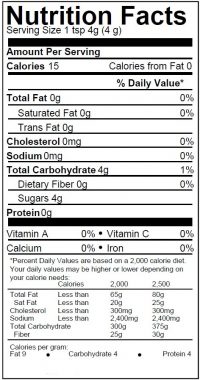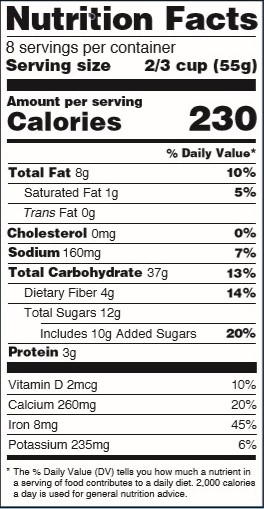I want to help you manage your type 2 diabetes naturally. Controls For Diabetes may collect a share of sales or compensation from the links on this page.
 What Is Carb Counting For Diabetes?
What Is Carb Counting For Diabetes?
A person with diabetes whether type 1 or type 2 must know their intake of carbs to adjust proper amount of medication accordingly. I am a carb counter and do it without thinking through the Low Carb High Fat (LCHF) diet. This means by eating healthy, natural foods, the carb intake will be low. What is carb counting for diabetes? I will explain.
What is a carbohydrate?
A carbohydrate is also known as a carb and comes from fruits, vegetables, and milk which are one of the three key nutrients, or building blocks, which make up the foods we eat. The other two building blocks are proteins and fats. We need to have all 3 to be healthy and strong.
Many of the foods we eat are a combination of all three of these building blocks. In a person with diabetes, the intake of carbs will raise the blood sugar also known as glucose as the stomach, and small intestines digest the food.
[1] Many foods with carbs taste good and are healthy. They provide energy and fuel for your body along with vitamins, minerals, and fiber that the body uses. If you consume more carbohydrates than your body needs, it stores some of those carbs as glycogen in the liver, in muscles, and the remainder as fat. People that follow low carb diets count grams of carbohydrate rather than calories and are concerned with net carbs. These carbs have an impact on blood sugar and insulin levels.
Which foods contain carbs?
See below:
- Fruits, honey
- Milk
- Vegetables
- Cereal, grain, noodles, pasta, crackers
- Snacks, chips, corn chips, energy bars
- Soft drinks, pop, diet pop, energy drinks, juice
- Candy, pastries, energy bars, cookies
- Beans, peas, lentils legumes
- Processed/packaged food
- Beer
- Nuts
- Sugar, sugarcane, sugar sweeteners, artificial sweeteners
Net Carbs
Net carbs are the weight in grams of the total carbs in food minus its grams of fiber. Fiber is a carb that your stomach and intestines cannot digest, it does not raise your blood sugar levels or trigger an insulin response. The fiber in the digestion process slows the absorption of any other carbohydrates, mitigating blood sugar spikes and insulin release. For low-carb dieters, fiber carbs don’t count as carbs.
For example, a 1-cup serving of cooked broccoli provides 11 grams of total carbs and 5 grams of fiber for a net carb total of 6 grams. Manufacturers of these type of products do the math for you, which will show net carb counts on the outside of the package on the Nutrition Facts Label.
How do you read a Nutrition Facts Label?
If you eat packaged foods, a convenient way to figure out how much carbohydrates are in your food is to use the “Nutrition Facts Label.” The “Nutrition Facts Label” is found on the outside of the food package.
Three factors for counting Carbs
- Serving Size
- Number of Servings Per Container
- Grams of Total Carbohydrate per serving
The total carbohydrate tells how many grams of carbohydrate are in one serving. A quick note some packages will have more than one serving. If you eat more than one serving, you will need to multiply the grams of carbohydrate accordingly.
Example of a Nutrition Facts Label

The grams of sugar are part of the total carbohydrate amount, so you do not need to count this sugar amount separately. The grams of sugar listed include both natural sugars, from fruit or milk, and any other added sugars.
Sugar Alcohol/Sugar Sweetener
Some foods marketed to low-carb dieters and diabetics contain reduced-calorie sweeteners called sugar alcohols, which despite the name, are alcohol-free.
Examples are:
- Sorbitol
- Mannitol
- Xylitol
- Erythritol
- D-Tagatose
- Isomalt (Palatinat)
- Lacititol
- Maltitol
- HSH Hydrogenated Starch Hydroslsates, Maltito
- Glycerol
- Polydextrose
Artificial Sweeteners, Pending Approval by the FDA
- Alitame
- Cyclamates
- Neohesperdine
- Thaumatin
You can find them in the following products: sugar-free or reduced-sugar snack bars, diet pop, syrups, candy, baked goods, ice cream, yogurt, and chewing gum. Sugar alcohols have an unpredictable effect on blood sugar levels, according to the American Diabetes Association. Here is an updated Nutrition Facts label.
 The Nutrition Facts label list sugar alcohols under total carbohydrate. A reduced-sugar snack bar containing 37 grams of total carbs with 4 grams of fiber and 10 grams of a sugar alcohol would have a net carb count of 33 grams. In reality, there have been no long term studies on artificial sweeteners, but in my opinion, it is the worst thing you could consume. Do we know anything about these chemical additives? The answer is no. Just because it is sweet or sweeter does not mean it is good. In fact, it is toxic, and you are spiking your blood sugar, in essence slowly causing harm to your body by consuming this.
The Nutrition Facts label list sugar alcohols under total carbohydrate. A reduced-sugar snack bar containing 37 grams of total carbs with 4 grams of fiber and 10 grams of a sugar alcohol would have a net carb count of 33 grams. In reality, there have been no long term studies on artificial sweeteners, but in my opinion, it is the worst thing you could consume. Do we know anything about these chemical additives? The answer is no. Just because it is sweet or sweeter does not mean it is good. In fact, it is toxic, and you are spiking your blood sugar, in essence slowly causing harm to your body by consuming this.
So far so good you are still here and reading this, excellent.
How many carbs should a person with diabetes eat?
Currently, dieticians recommend 150 grams of carbs per day, so for each meal if we divide by three that would mean 50 grams. Why do we have to have three meals? You don’t. These are the only recommendations from the health establishment/dieticians, and that is insane. For a person with diabetes that is way too much. It should be one-third of that or 50 grams per day, total. If we now break that down each meal should consist of 16.5 grams of carbs per meal give or take a gram here or there.
If you want to go lower as Dr. Bernstein (diabetologist) suggests at 42 grams even better. No one says you cannot eat less say 20 or 25 grams. If you eat at this pace every day, your type 2 diabetes will go away in no time. Do you know what the good news is? You can eat a lot of meat, fish, eggs, and chicken cooked in lots of butter. OK, cool, guess what? Zero, nada, nil, 0 carbs. I am sarcastic sorry let’s get back on track.
Do you want to lower your insulin and also get rid of type 2 diabetes? If you do, you will not have to count carbs, but you will have to switch to an LCHF diet. For details of the LCHF diet go here LCHF Diet and then check out Intermittent Fasting.
Summary
What is carb counting for diabetes? It is counting your carb intake and keeping it as low as possible so that you can lower your medication and for type 2 diabetes possibly reverse the disease. Eat real natural foods until you are satisfied. The magic number for carb counting is 50 grams or less per day. High blood sugar is toxic. Quit sugar and sugar sweeteners today or as soon as you possibly can. I recommend this because I have quit sugar, I am on an LCHF diet, and I have put my type 2 diabetes into remission.
Consult your doctor before making any dietary changes. Only you can help yourself, get yourself tested and get a glucometer.
References
- Diabetes and Carb Counting For Dummies, John Wiley and Sons Inc., Sherri Shafer. 2017
Recommended Reading (See also Recommended Books To Read)
Good Calories, Bad Calories: Fats, Carbs, and the Controversial Science of Diet and Health, Anchor Books, Gary Taubes, 2007.
Diabetes and Carb Counting For Dummies, John Wiley and Sons Inc., Sherri Schafer, 2017.
I appreciate and welcome all comments, questions, and concerns. Please send me an email.
Many thanks for dropping by and viewing.

I am not understanding the example you gave with the sugar alcohol. Where does the 10 net gram of carbs come from? If the total is 16 grams with fiber is 2 grams and 8 sugar alcohol, how does it end up net 10 grams carbs?
Hello Dinh
I thank you for pointing this typo out to me and I will correct it. Not sure what I was thinking, but the total fiber should read 6 grams and I will correct it with a new updated nutrition label.
The corrected label will read 16 grams of carbs minus the 6 grams of fiber will give you a net total of 10 grams. The label will not tell you the total net carbs you will have to figure that out through the math.
The sugar and sugar alcohols will be included under carbs and will not make any difference to the carb content.
Appreciate and thank you for taking the time to read this post.
Ah, now I get it.
I knew about fiber being subtracted from the total carbs but I was unsure where the sugar can in. Your example now makes sense 🙂
Hello Dinh,
I have now added a new FDA label and you can now see the new updates. The added sugar as I mentioned before is the sugar additives and sugar alcohol. It is not counted into the total carbs. Not sure if I like this, but it is not my call. Stay away from sugar, added sugar, sugar additives and anything related to sugar. Sugar to me is toxic and adds to insulin resistance. You could have insulin resistance, metabolic issues, and a fatty liver before you have type 2 diabetes. Eat healthy whole natural unprocessed food and you will live a long healthy life. Type 2 diabetes is a slow painful killer. Read my other post entitled “Can too much sugar cause diabetes” there are some great books on the subject of sugar that I highly recommend you read at the bottom of that post. Many thanks for dropping by and following up on your first comment.
I never thought of the sweeteners as sugar alcohols before but now seeing the -ol endings of the words sorbit-ol, mannit-ol, xylit-ol etc. my biochemistry is kicking in after all these years.
I am skeptical of these artificial sweeteners as well. I am all for whole foods or products manufactured from whole foods. I don’t like the idea of “chemical ” foods more than likely prepared in a lab.
Hello Anne
I am glad your biochemistry is kicking in. People must know that sugar and sugar sweeteners are toxic to anyone and in particular a person with diabetes. I appreciate your comments.
Thanks.
Jimmy.
Having friends with diabetes, I believe this post will be beneficial for them, and it has enough information to know what they should eat and what they should do regarding the carb counts limit. Your suggestion in conclusion about consulting doctors before doing any diet changes is a nice touch because some people just follow what they see on the internet and not ask the doctor anymore. Excellent article!
Hello Nico
I am glad that you can pass this over to your friends with diabetes, educated people can make better decisions and control their blood sugar.
Thanks for your comments.